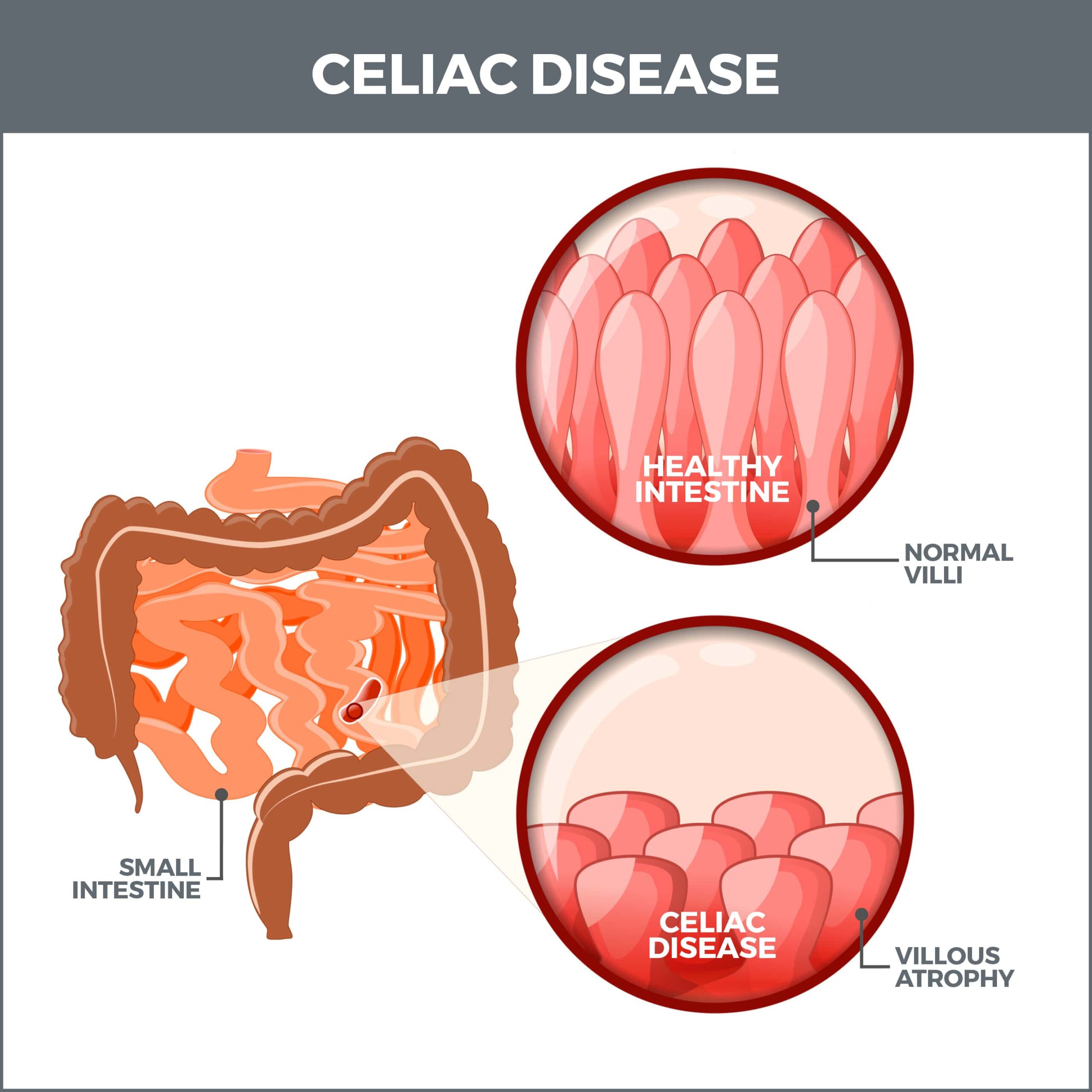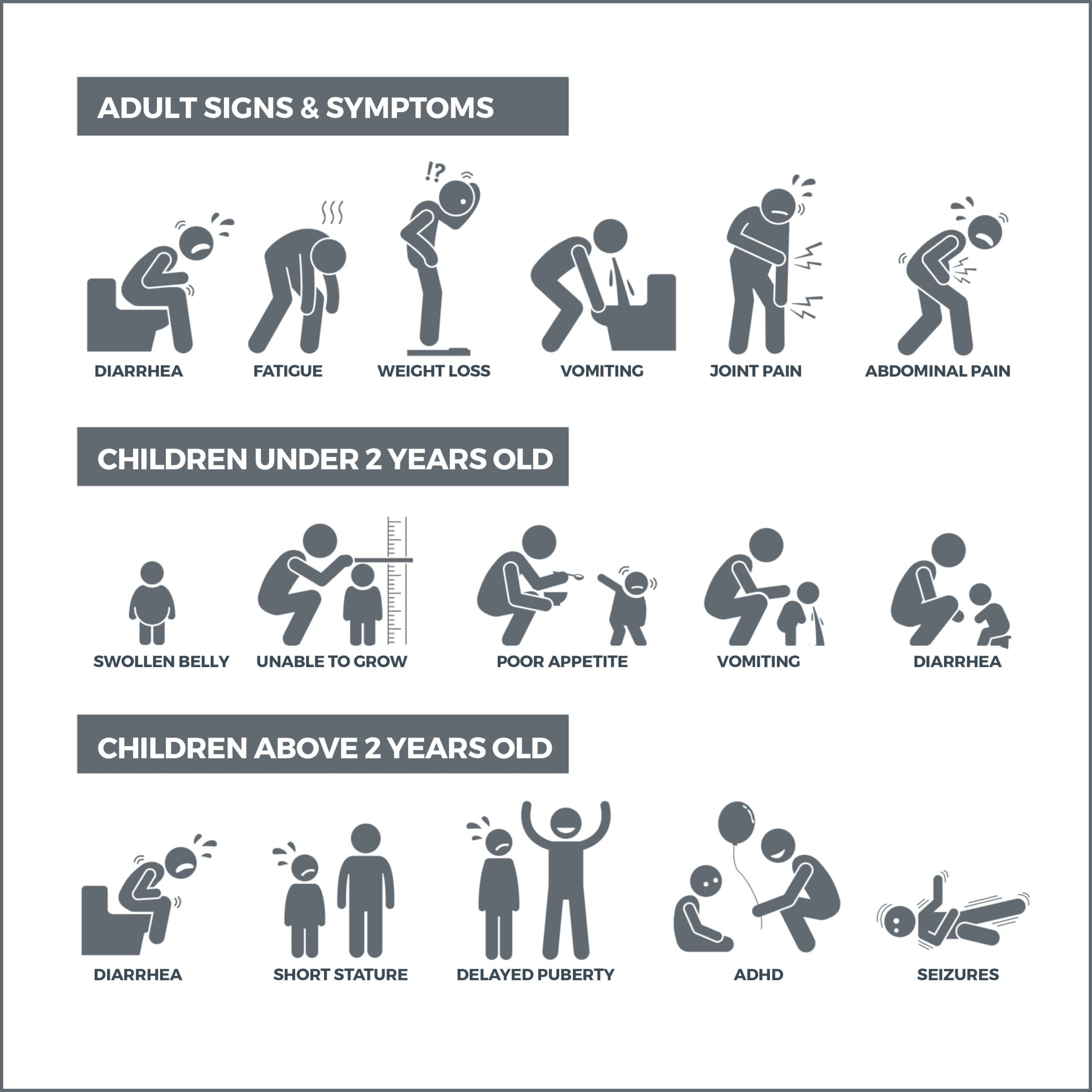
Celiac Disease
Celiac disease is a chronic autoimmune disorder triggered by eating gluten. Gluten is a naturally occurring protein within barley, rye, and wheat. It adds texture and flavor to food and is used as a binder to give processed foods shape.
When someone with celiac disease eats gluten, their immune system misinterprets it as a threat and attacks the small intestine’s lining. As this onslaught progresses, it prevents the intestine from absorbing nutrients and can lead to serious complications such as malnutrition and permanent intestinal damage.
What Causes Celiac Disease?
Celiac disease is a genetic disorder. You can inherit the disease’s genes from either your mother or father or both parents. The autoimmune response that it triggers destroys structures in the small intestine’s wall called villi. Villi are tiny, hair-like protrusions that help the body absorb nutrients from your food. When the villi are injured or destroyed, the body cannot process nutrients, regardless of how much you eat.

What Are the Symptoms of Celiac Disease?
No two people have the same symptoms or combinations of symptoms. Each person is affected in different ways, but common symptoms include:
- Lactose intolerance.
- A severe skin rash (dermatitis herpitiformis) that forms on the buttocks, back, neck, or scalp.
- Mouth ulcers.
- Malnutrition.
- Anemia (iron deficiency) or hepatitis (liver inflammation).
- Weight loss from lack of nutrients.
- Muscle cramps, joint pain.
- Loss of bone density (osteoporosis).
- Constipation, gas, diarrhea, abdominal bloating, foul-smelling stools.
- Seizures and tingling legs due to nerve damage.
- Headaches, balance difficulties.
- Female reproductive problems such as infertility and miscarriage.
- Irregular menstrual periods.

If you have celiac disease, you may also have other autoimmune conditions such as:
- Type 1 diabetes.
- Sjogren’s Syndrome (a disease that attacks the glands that make moisture in the mouth, eyes, and other parts of the body).
- Autoimmune liver disorder.
- Anemia.
- Down Syndrome.
- Rheumatoid arthritis.
- Lupus.
- Thyroid disease.
- Liver disease.
How is Celiac Disease Diagnosed?
Doctors typically use blood tests and intestinal biopsies to identify celiac disease. These evaluations include:
- Serology Test: This test identifies antibodies (proteins that protect your body from illness) in your bloodstream. High levels of certain antibodies may be present in the blood of people with celiac disease.
- Complete Blood Count (CBC): A CBC is a blood test that can detect low iron levels indicative of anemia related to celiac disease.
- HLA Genetic Test: This blood test determines if you have genetic mutations corresponding to celiac disease.
- Liver Function Test: A liver function test determines if you have abnormally high or low levels of enzymes and proteins caused by celiac disease.
- Cholesterol Test: This test measures cholesterol and other fats in your blood.
- Alkaline Phosphate Test: If you have a low level of alkaline phosphates, it could indicate malnutrition related to celiac disease.
- Upper Endoscopy: During an upper endoscopy, a long, thin tube outfitted with a small camera will be passed down your throat and into your small intestine, so your doctor can collect a tissue sample and assess damage to the villi. It is important to continue to consume gluten before this test. If you stop eating gluten before, the results may be inaccurate. Six to eight weeks before the procedure, eat three to 10 grams of gluten daily. If you still have severe symptoms and can’t tolerate having gluten for this long, you can still have a biopsy after only two weeks.
- Capsule Endoscopy: You’ll swallow a vitamin-size capsule containing a camera for this procedure. Traveling through your digestive tract, it takes thousands of pictures for analysis by your doctor.
Treatment
If you have celiac disease, you must abstain from all foods containing gluten. This is the only treatment for the condition. If you stop eating gluten, the disease’s symptoms usually end in several days. The villi take months or years to completely heal.
Even if the symptoms subside, you must stay on a gluten-free diet for the rest of your life. You’ll need to refrain from eating even small amounts of gluten, which can reinjure the villi and reactivate the disease. You must also be wary of cross-contamination, which happens when gluten-free foods come in contact with substances containing gluten.
Some of the gluten-containing foods and drinks you should avoid include:
- Breads.
- Cakes.
- Gravy.
- Ice cream.
- French fries.
- Soy sauce.
- Condiments.
- Pasta.
- Pizza.
- Processed meat.
- Canned soup.
- Potato chips.
- Cereals.
- Salad dressing.
- Beer.
- Lager.
- Ale.
- Wine coolers.
You’ll need to closely read food labels because items that seem okay to eat may actually have additives that contain gluten, such as:
- Malt vinegar and malt syrup.
- Soy.
- Modified food starch.
- Maltodextrin.
- Emulsifiers.
- Hydrolyzed plant protein.
- Dextrin.
- Caramel.
The FDA requires that food labels show whether an item contains trace amounts of allergens. For instance, a label may say, “Contains wheat, soy, and milk.” It may also show that the product was made in a facility that uses the ingredient to warn about possible cross-contamination.
Gluten can also be present in less obvious items, including:
- Lipstick.
- Toothpaste and mouthwash.
- Envelope and stamp glue.
- Hair products (although you don’t eat these, you may accidentally transfer them from your hands to your mouth).
- Chewing gum.
- Herbal supplements.
- Vitamins and minerals.
- Over-the-counter and prescription medications.
- Licorice.
Gluten-free foods include:
- Berries, peaches, bananas, oranges.
- Fresh, lean fish, chicken, and meats (without breading).
- Rice, beans, lentils.
- Peas, potatoes, sweet potatoes, cauliflower, broccoli.
- Eggs.
- Low-fat dairy.

Your doctor may refer you to a registered dietician who can work closely with you to create a personalized diet plan.
If you start a gluten-free diet without guidance from your doctor or a dietician, you risk a deficiency in nutrients such as iron, fiber, and calcium. Some prepackaged gluten-free foods may contain more sugar and fat than foods containing gluten.
How Do I Maintain a Gluten-Free Diet When I’m Out?
You can maintain a gluten-free diet at restaurants and social functions if you do a little research beforehand:
- Check out restaurant menus online or call to find out if they serve gluten-free foods.
- Let your server know you have celiac disease. Find out how the food is prepared and what ingredients it contains. Ask to see the chef if you need more information.
- Before social gatherings, inform the host that you have celiac disease. Ask if they’ll be serving gluten-free foods. If they do not have any gluten-free options or are uncertain that their foods may contain gluten, it is recommended to bring your own.
Contact Us
Contact us today! The team of professionals at GastroMD looks forward to working with you. We are one of the leading gastroenterology practices in the Tampa Bay area. We perform a host of diagnostic procedures using state-of-the-art equipment in a friendly, comfortable, and inviting atmosphere where patient care is always a top priority!



